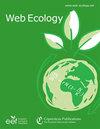An approach to the modeling of honey bee colonies
IF 2.4
3区 环境科学与生态学
Q2 ECOLOGY
引用次数: 2
Abstract
Abstract. In this work, populations of adult and immature honeybees and their honey production are studied through mathematical and statistical modeling approaches. Those models are complementary and are presented in disjunct form. They were used to show different modeling methods for honey bee population dynamics. The statistical approach consisted of a generalized linear model using data from the Department of Agriculture of the United States of America (USDA), which showed that the relationship between the number of colonies and the rate of honey production is not constant in time but decrease over the years. These models showed that when a bee population is subjected to a stress factor (i.e., habitat destruction, Varroa mite, climate variability, season, neonicotinoids, among others), the abundance of individuals decreases over time as well as the honey produced by the colonies. Finally, the mathematical approach consisted of two models: (1) a smooth model, in which conditions of existence and stability of the equilibrium solutions are determined by an ecological threshold value, and (2) a non-smooth model where the mortality rate of bees is included as a function of the number of adult bees in the population.蜂群建模的一种方法
摘要在这项工作中,通过数学和统计建模方法研究了成年和未成熟蜜蜂的种群及其蜂蜜产量。这些模型是互补的,以分离的形式呈现。它们被用来展示蜜蜂种群动态的不同建模方法。统计方法采用美国农业部(USDA)数据的广义线性模型,表明蜂群数量与蜂蜜产量之间的关系在时间上不是恒定的,而是逐年递减的。这些模型表明,当蜜蜂种群受到压力因素(即栖息地破坏、瓦螨、气候变化、季节、新烟碱等)时,个体的丰度会随着时间的推移而减少,蜂群生产的蜂蜜也会减少。最后,数学方法由两个模型组成:(1)平滑模型,其中平衡解的存在条件和稳定性由生态阈值决定;(2)非光滑模型,其中蜜蜂死亡率作为种群中成年蜜蜂数量的函数。
本文章由计算机程序翻译,如有差异,请以英文原文为准。
求助全文
约1分钟内获得全文
求助全文
来源期刊

Web Ecology
Agricultural and Biological Sciences-Ecology, Evolution, Behavior and Systematics
CiteScore
4.60
自引率
0.00%
发文量
6
审稿时长
17 weeks
期刊介绍:
Web Ecology (WE) is an open-access journal issued by the European Ecological Federation (EEF) representing the ecological societies within Europe and associated members. Its special value is to serve as a publication forum for national ecological societies that do not maintain their own society journal. Web Ecology publishes papers from all fields of ecology without any geographic restriction. It is a forum to communicate results of experimental, theoretical, and descriptive studies of general interest to an international audience. Original contributions, short communications, and reviews on ecological research on all kinds of organisms and ecosystems are welcome as well as papers that express emerging ideas and concepts with a sound scientific background.
 求助内容:
求助内容: 应助结果提醒方式:
应助结果提醒方式:


